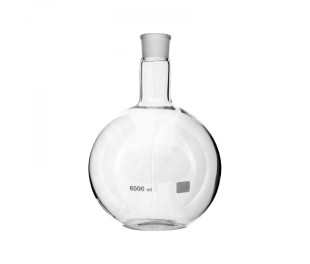Flat Bottom Flask with socket
Flat Bottom Flask with Socket - Stable Base Meets Modular Chemistry
When you need a flask that won't tip over during extended heating sessions but still connects seamlessly to your distillation train, flat bottom flasks with socket deliver both stability and versatility. The flat base sits securely on hot plates and stirrers without requiring support stands, while the ground glass socket lets you attach condensers, thermometers, and addition funnels just like you would with a round-bottom flask with socket.
Ground Glass Joint Integration for Modular Setups
Socket joints transform these flasks from simple containers into connection points for complex apparatus. The precision-ground female joint accepts male ground glass components without grease in many applications, though a thin layer helps when working under vacuum. You'll find these flasks particularly useful when your laboratory boiling flasks or round bottom alternatives require clamp support that complicates your bench layout.
Standard Taper Socket Specifications
- 14/20 sockets: Common in micro-scale work and smaller volumes up to 100mL
- 19/22 sockets: Standard for 100mL to 500mL capacities in educational and research labs
- 24/29 sockets: Preferred for 500mL to 2000mL flasks handling larger synthesis batches
- 29/32 and 34/45 sockets: Available for industrial-scale preparations exceeding 2L
Borosilicate 3.3 glass construction handles thermal shock from -70°C to +500°C, though rapid temperature changes still risk cracking.
Distillation and Reflux Assembly Uses
These flasks work well as receiving vessels in distillation setups where you need the collection flask to sit flat without additional support hardware. Unlike a traditional round bottom flask that requires a clamp or cork ring, the flat base stays put while you adjust your condenser angle. For reflux reactions, the socket accepts a condenser directly while the stable base prevents tipping from magnetic stirrer vibration. Consider a conical flask with a wide throat when you need better mixing efficiency, but stick with flat bottom designs when bench space is limited and you're running multiple reactions simultaneously.
Vacuum-Tight Connection Benefits
Socket joints create reliable seals for reduced-pressure applications when properly greased. Rotary evaporation receiving flasks benefit from the flat bottom design since they sit level during solvent collection. The socket connection maintains vacuum integrity better than rubber stoppers, which compress and leak over time. Pro tip: Clean socket joints with acetone between uses to prevent frozen joints from residue buildup, and store flasks with joints facing down to keep dust out.
Our partners
We only work with trusted brands
Sign up to our newsletter to get the latest news and updates about our products.







